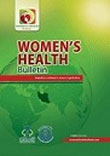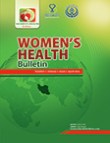فهرست مطالب

Women’s Health Bulletin
Volume:4 Issue: 2, Apr 2017
- تاریخ انتشار: 1396/02/20
- تعداد عناوین: 7
-
-
Page 2Context: Obesity is a major public health problem worldwide. This review aimed at providing an updated overview of obesity in Iranian women and its associated complications..
Evidence Acquisition: In this narrative review study, related systematic reviews or meta-analysis studies of high ranking journals conducted from 2000 to 2016 were searched in the PubMed, Medline, and Scopus with the following keywords: women OR female AND weight OR overweight OR obesity, risk factors OR complications, reproduction OR cancer OR cardiovascular disease OR diabetes OR gestational diabetes OR maternal obesity OR fertility OR pregnancy OR polycystic ovary syndrome OR management..ResultsIn Iran, women have shown a constantly higher risk of obesity compared to men. After a 9- year follow-up, the age-standardized incidence rate (95% CI) of diabetes was 10.1 (7.24 - 13.9) in women. The increases in overweight and obesity in menopausal women have an important role in endometrial, colon, and breast cancer. Obesity increases the risk of endometrial cancer 2.4 to 4.5 folds compared to the normal weight women. Maternal obesity increases the risk of gestational hypertension 4.5 to 8.7 times compared to normal weight women. An increasing number of obese women becoming pregnant is associated with short- and long-term maternal and child outcomes. The prevalence of childhood obesity in children of obese women aged 3 to 5 years increases up to 25%; and these children have an almost 6- fold chance of being obese in young adulthood. Weight reduction of obese women is accompanied with lower incidence of obesity complications. The most effective interventions are multiple behavioral management activities..ConclusionsConsidering the large population of young people in Iran and the lack of any effective preventive policy, the burden of obesity and its associated outcomes will be problematic in the near future..Keywords: Women, Obesity, Reproduction, Cancer, Cardiovascular Disease -
Page 3BackgroundNurses are one of the most significant group exposed to the risk of acquired immune deficiency syndrome (AIDS). Therefore, to determine the disease level in patients and train them in the field are among the most essential subjects of nursing education. The study investigated the nursing students awareness, attitudes and tendency toward providing services to patients with HIV/AIDS..MethodsThis cross-sectional study, conducted in 2014, covered 110 second- and third-year nursing students from Isfahan University of Medical Sciences, Isfahan, Iran. The research tools were demographics and AIDS knowledge questionnaires, an attitude towards AIDS scale and a discrimination against patients questionnaire. The information was analyzed by SPSS using descriptive statistics, t-test and the Pearson correlation coefficient..ResultsMales comprised 38.2% of the subjects, and females 61.8%. About 80% of the participants were single and 20% married. Almost two-thirds (60.9%) had a professional background. Regarding the awareness of AIDS and its transmission methods, 52.7% of the students were a little aware. Furthermore, 84.5% of students were at the moderate level of discrimination on giving services and taking care of patients with HIV; 52.2% of the subjects were also at a moderate level. A significant direct relationship was observed between the discrimination and attitude scores, P = 0.04 and r = 0.19..ConclusionsThe students levels of awareness of HIV and its transition methods were low, and this should be promoted thorough training. Discriminatory actions do occur, and it is necessary and possible to decrease their incidence by promoting students awareness of patients rights and ethical principles..Keywords: Awareness, Attitude, Stigma, Students
-
Page 4BackgroundDesired number of children is one of the main indexes showing the fertility preferences of couples. This issue is currently more important as Iranian policy makers are revising population policies to improve fertility rate..ObjectivesAs a result, the main goal of this study was to investigate factors influencing the number of desired children among married women in the reproductive age. A theoretical framework was constructed based on demographic transition theory, demand-supply theory and diffusion theory..MethodsThis study was a quantitative research and its research technique was survey. The population of the study included all married women at the reproductive age (15-49), who were living in Shiraz County (Shiraz city and surrounding rural areas). Data was collected by interviews with 626 women, who were selected by multi cluster sampling and purposive sampling during year 2014. Data was analyzed by the SPSS (version 22) software..ResultsThe findings showed that the desired number of children both in Shiraz city and its surrounding rural areas was exactly below the replacement rate. In addition, findings of this study demonstrated that the desired number of children as a dependent variable is affected by a set of socioeconomic and cultural factors. Results have revealed that the main predictors are couple agreement on the number of children, respondents income, son preference, respondents authority and ethnicity..ConclusionsOverall, the variables considered in the research model explained only 32.7% of change in the dependent variable. This means that 67.3% of change in the number of desired children is related to factors that are not included in the research model. Moreover, most of the women in Shiraz County desired to have a small family size and this fact can result in further decline of fertility rates in the future because couples respect their desires in fertility. As a result, it is recommender for policy makers to pay more attention to factors influencing the desired number of children..Keywords: Desired Number of Children, Fertility, Family Planning, Health Policy, Population Policy, Shiraz County, Iran
-
Page 5BackgroundMaternal mortality remains a public health concern in low income countries particularly in sub-Saharan Africa where majority (62%) of maternal deaths occurs. In Tanzania maternal mortality ratio is as high as 432 deaths per 100,000 live births..ObjectivesThis study aimed to describe pattern of maternal mortality ratio and its associated causes at Shinyanga regional referral hospital. We also assessed the availability of the comprehensive emergency obstetric care services in the study setting..MethodsThis was retrospective cross-sectional study which was conducted from April to May 2015 at Shinyanga Regional Referral Hospital. Information on demographic data, obstetric factors associated with maternal death and their causes as well as their management were extracted from the patients record file between 2010 and 2014 by using data extraction sheet. Data analysis was performed using SPSS version 18.0 for Windows (SPSS Inc, Chicago, IL, USA). Descriptive statistical analysis were summarized..ResultsOverall maternal mortality ratio declined from 635/100,000 live births in 2010 to 449/100,000 live births in 2014. The main causes of maternal death were postpartum haemorrhage (50%) and pre-eclampsia/eclampsia (20%). Majority (77%) of the delays were encountered at hospital and at home (56%). Numerous forms of management were provided to women who experienced maternal death including C-section (35.5%) for antepartum haemorrhage and hysterectomy (17%) for postpartum haemorrhage. For pre-eclampsia/eclampsia, only 12.5% had C-section. Of all of the maternal deaths, only 2.5% had assisted vaginal delivery and 14% had puerperal sepsis..ConclusionsThe observed maternal mortality ratio in this population is higher compared to the national average. Postpartum haemorrhage and preeclampsia/eclampsia remains to be the main direct causes of maternal deaths. Delay in decision making in seeking fortreatment and provision of treatment contributed to high maternal mortality observed in this study. This requires more effort to address the direct and indirect causes of maternal death..Keywords: Maternal Mortality, Risk Factors, Causes, Shinyanga, Tanzania
-
Page 6BackgroundVaginitis is a common medical problem in females. Bacterial vaginosis, vulvovaginal candidiasis and trichomoniasis are the main etiologies of infectious vaginitis..ObjectivesThis study was designed to assess the relationship between contraceptive methods and common vaginal infections..MethodsIn this cross-sectional study, 250 females were evaluated from December 2012 to February 2013. The researcher-made questionnaire included questions about individual characteristics and contraceptive methods. The participants underwent a gynecological exam. Specimens were collected from posterior fornix of the subjects and polymerase chain reaction assay was done to diagnose vaginitis. Data were analyzed using SPSS statistical software (version 17) and also descriptive and analytical statistics (chi-square, t test and fishers exact test). P values ofResultsOn the basis of the findings, 43.6% of females suffered from vaginitis. Overall, 65.56% of participants used contraceptive methods. Condom use was the most prevalent method of contraception. A significant relationship was found between suffering from different types of common vaginal infections and using contraceptive methods (P = 0.017). The percentage of females with candidiasis amongst hormonal contraceptive users, and the percentage of individuals amongst non-hormonal contraceptive users were higher than the others..ConclusionsContraceptives can increase the risk of vaginitis. Hence, health care providers should consider the probability of vaginitis in addition to the indications and contraindications of contraceptive methods and should guide couples in taking a step forward for improving their sexual and reproductive health..Keywords: Contraceptive Methods, Polymerase Chain Reaction, Vulvovaginal Candidiasis, Trichomoniasis, Bacterial Vaginosis
-
Page 7IntroductionAcardiac twin refers to a monochorionic pregnancy in which there is a twin with absent or nonfunctioning heart and a normal co-twin. This was a very rare disorder of monozygotic twin pregnancy. The aim of this report was to introduce a case of acardiac acephalus twin pregnancy..Case PresentationA 32- year- old woman (G3 P2 L2) referred to the hospital because of a decrease in fetal movement at 32 weeks of gestation. Ultrasonography showed a dead fetus. Her earlier sonography showed the possibility of acardiac twin pregnancy, but she did not have any appropriate or special prenatal care for this problem. After delivery, there was a normal dead fetus without any gross abnormality and another acardiac fetus..ConclusionsEarly diagnosis of acardiac twin pregnancy and appropriate prenatal care are of prime importance for appropriate intervention and best fetal outcomes..Keywords: Acardiac Acephalus, Twin Pregnancy, Twin Reversed Arterial Perfusion


